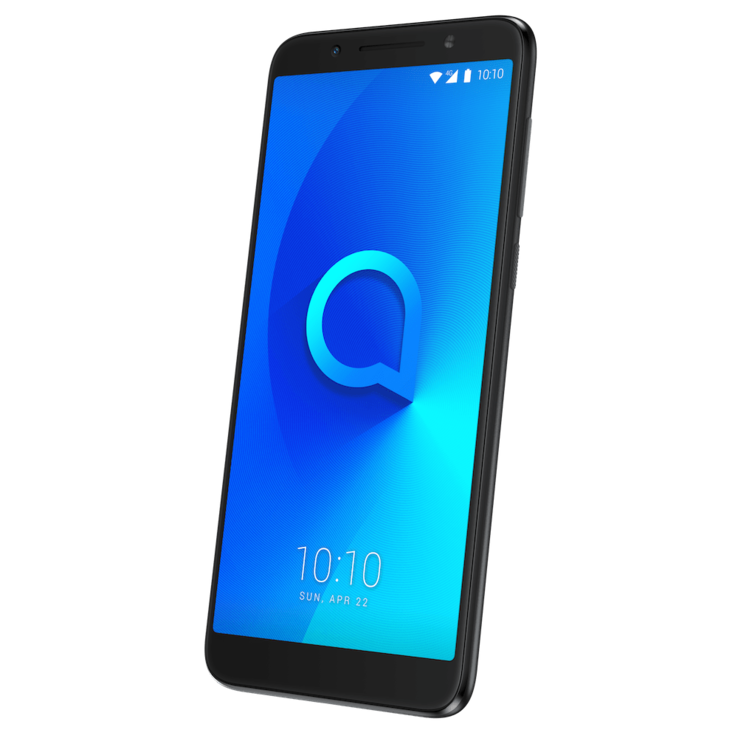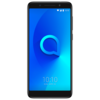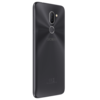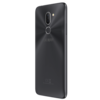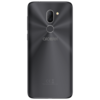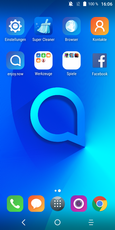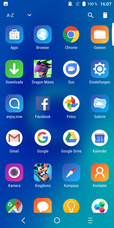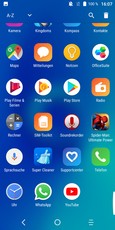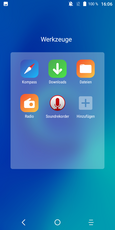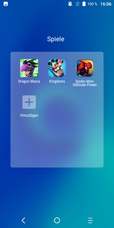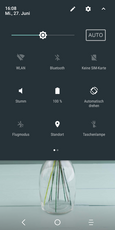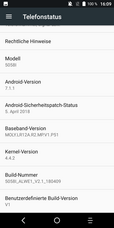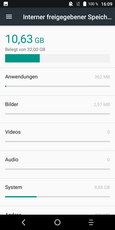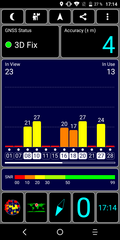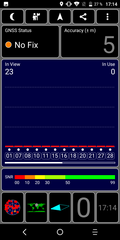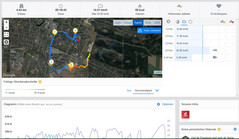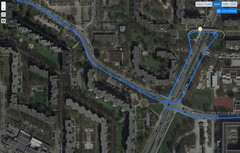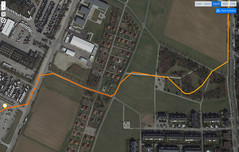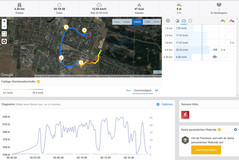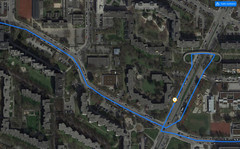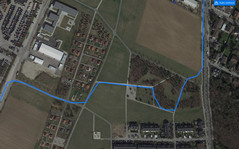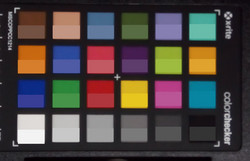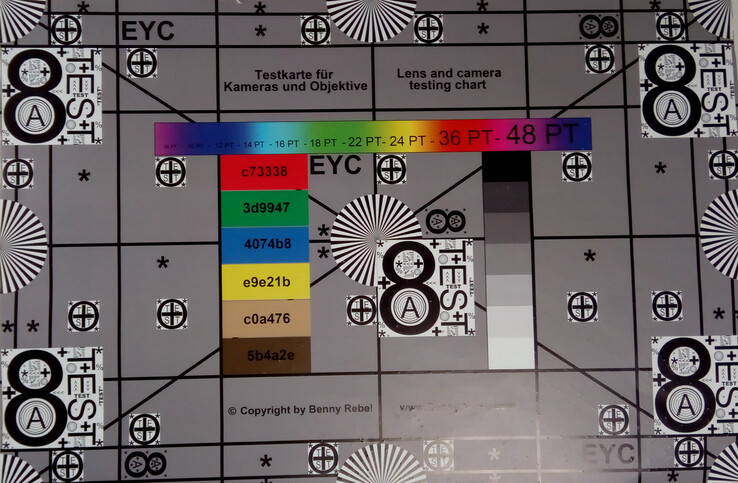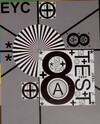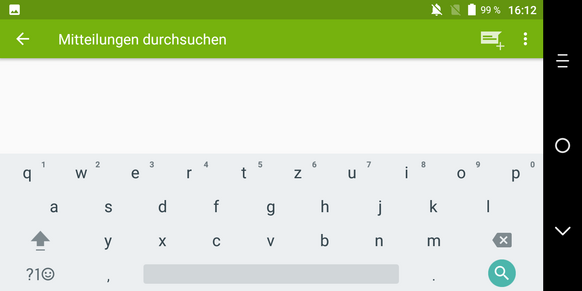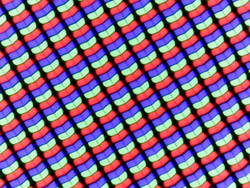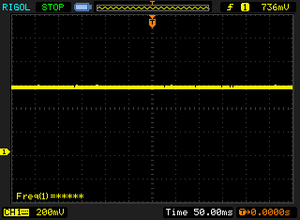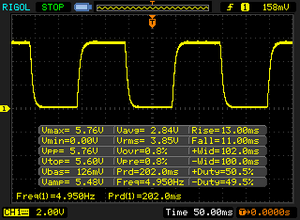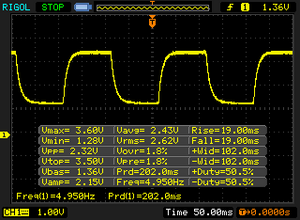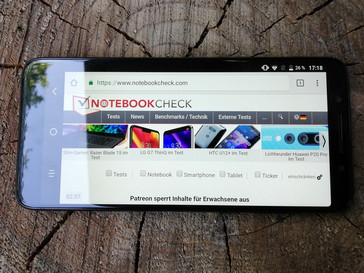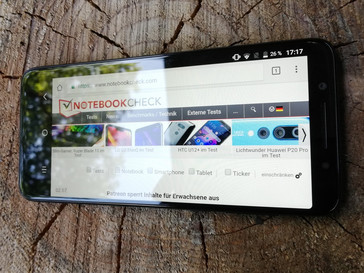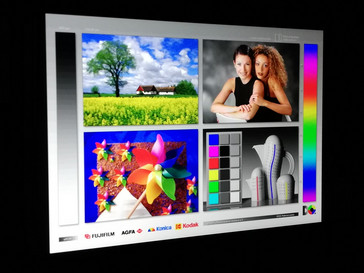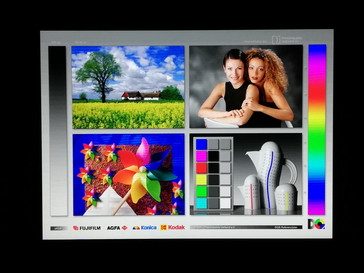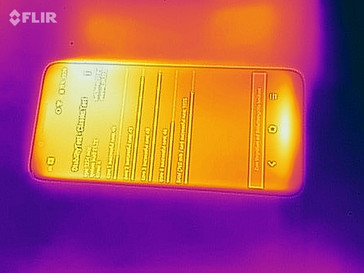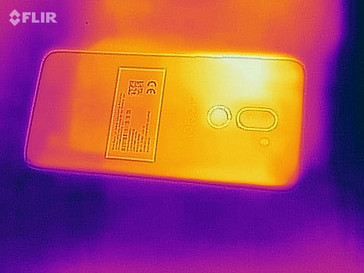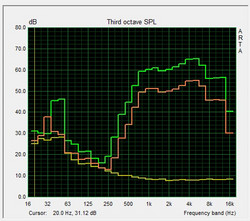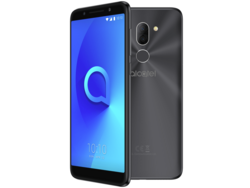Alcatel 3X Smartphone Review
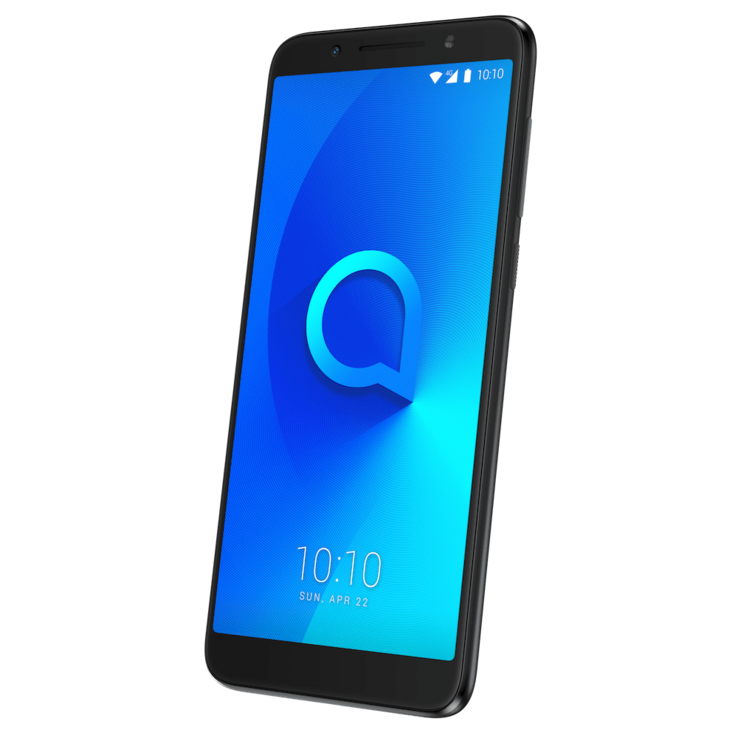
We reviewed the Alcatel 5 and the Alcatel 3V a couple of weeks ago. The Alcatel 3X is the best-priced Alcatel smartphone that we have reviewed so far. It competes directly against other low-priced, powerful smartphones. The MediaTek MT6739 and the Imagination PowerVR GE8100 form a solid foundation for the mid-range smartphone. In addition, the Alcatel 3X packs 3 GB of RAM and 32 GB of eMMC flash memory, which should ensure the smooth operation of the OS (Android 7.1.1).
The Alcatel 3X has quite a few competitors in the 200-Euro ($233) price range. Many manufacturers offer similarly-equipped devices. We selected four of those for comparison purposes. The competing devices include: The Xiaomi Redmi Note 5, Huawei‘s Y7 (2018), the Moto G6 Play from Motorola and Umidigi‘s A1 Pro. The above-mentioned smartphones offer very similar specifications and cost almost as much as our review device.
Case – Alcatel smartphone with a radical design
The Alcatel 3X comes with a well-built plastic case and is available in the following color schemes: Black, Blue and Gold. The finish on the back that Alcatel describes as “radical details” consists of circular textures radiating away from the camera cutout. These textures span the entire back.The juncture at which the glass front meets with the plastic sides is smooth and uniform. The buttons are located on the right side of the device. The SIM/MicroSD card slot is located on the left side.
Connectivity – Mid-range smartphone with a headphone jack
The Chinese manufacturer TCL has equipped the Alcatel 3X with MediaTek’s mid-range SoC MT6739 and Imagination’s PowerVR GE8100 graphics unit. In combination with 3 GB of RAM and 32 GB of eMMC flash memory, the Android smartphone offers a very good level of performance for a device in this price range.
The smartphone has a Micro-USB port on the bottom. It operates at USB 2.0 speeds. The Alcatel 3X also features a headphone jack. You can insert either two SIM cards or one SIM card and one MicroSD card in the slot on the left side of the device.
Software – Alcatel smartphone with Android Nougat
The Alcatel 3X runs Android 7.1.1 (Nougat). The security patches were last updated on the 5th of April of 2018. The Chinese smartphone comes with the stock version of Android. However, the icons have been changed and OfficeSuite has been pre-installed. In addition, there are a few games and the Alcatel app "enjoy.now". In this app, you can find news, tutorials and other information about the Alcatel smartphone. You can set up multiple accounts for different users in the settings menu if more than one person is going to use the device. Moreover, you can assign different apps to different fingers so that when you scan a certain finger with the fingerprint sensor the app associated with that finger will open.
Communication and GPS – an LTE smartphone from Alcatel
The Alcatel 3X supports the following mobile communication standards: GSM, UMTS and LTE. The LTE module operates at Category 4 speeds (download: 150 Mbit/s, upload: 50 Mbit/s). For short-distance communication, the Android smartphone relies on Bluetooth 4.2 and Wi-Fi.
The Alcatel 3X supports the IEEE-802.11 standards b, g and n. This is why our review device can only offer mediocre transfer rates. In our Wi-Fi benchmarks, the Alcatel 3X takes the next-to-last spot.
| Networking | |
| iperf3 transmit AX12 | |
| Xiaomi Redmi Note 5 | |
| Huawei Y7 2018 | |
| Umidigi A1 Pro | |
| Alcatel 3X | |
| Motorola Moto G6 Play | |
| iperf3 receive AX12 | |
| Xiaomi Redmi Note 5 | |
| Umidigi A1 Pro | |
| Huawei Y7 2018 | |
| Alcatel 3X | |
| Motorola Moto G6 Play | |
We use the app called "GPS Test" to determine how good the Alcatel smartphone is at geo-location. Outdoors, the Alcatel 3X exhibits a margin of error of 4 meters (~13 ft) and uses both GPS and GLONASS. Indoors, our review device quickly loses its satellite connection and therefore is unable to determine the user’s location.
On our compulsory bike ride, the GPS of the Alcatel 3X does not prove to be very reliable. When moving at a low speed, the Alcatel 3X is, actually, a bit more accurate than our reference-grade navigator Garmin Edge 520. However, at a high speed, the Alcatel 3X becomes very inaccurate, to the point where entire curves and bends of the road are missed.
Telephony and Call Quality - Quiet conversations with the Alcatel 3X
The Alcatel 3X comes with the standard Android phone app. Therefore, making calls and finding contacts is easy. However, the speaker is not loud enough, which is why ambient noise can often drown out your call partner.
Things are similar in speaker mode. In this mode, the Alcatel 3X is also not loud enough. On the other end of the line, the Alcatel user sounds somewhat muffled, but intelligible. In addition, the Alcatel 3X supports VoLTE and VoWLAN. These functions can be enabled in the settings menu.
Cameras – Dual-camera for snapshots
The Alcatel 3X comes with a 13 and 5 MP dual-camera set-up with an f/2.0 and f/2.2 aperture. The front-facing camera has a 5 MP sensor and an f/2.4 aperture. This is why selfies look rather mediocre and suffer from noise even during daylight.
The photos taken with the main camera appear quite dim. Bright and dim areas are hard to distinguish from each other, and the images lack detail. When close to an object, the images taken with the Alcatel 3X appear more detailed and better resolved than the photos of distant objects. The low-light performance is good. The lack of sharpness is the only drawback here. The video quality is also good and the video recordings do not appear very shaky. There are a few filters and an LED flash for illuminating dark scenes. The Alcatel 3X’s camera does not offer any other features.
We use the X-Rite ColorChecker Passport to evaluate the color reproduction of the Alcatel 3X’s camera. This test confirms our impression that both the colors and the shades, such as shades of black and gray, are too dim.
Our test chart, which we photograph under controlled lighting conditions, is also too dim. The fine lines and details are well reproduced and there is only a slight loss of sharpness at the edges.
Accessories and Warranty – The Alcatel 3X comes with a stereo headset.
The box contains a USB charger with an appropriate USB cable and a stereo headset. Alcatel does not offer any other first-party accessories. Additional accessories can only be purchased from third parties.
The smartphone comes with a 24-month warranty. Please see our Guarantees, Return policies and Warranties FAQ for country-specific information.
Input Devices and Handling – Smartphone with good face recognition.
The Alcatel 3X uses Google’s GBoard as the default keyboard. Therefore, typing on the smartphone is fast and easy. The touchscreen responds promptly to inputs. Every touch is accompanied by a vibration. However, the motion sensor is not very responsive.
The Android smartphone can be easily unlocked with the fingerprint sensor on the back. The Alcatel 3X’s face recognition works even faster. This unlocks the device much faster than entering a PIN or drawing a pattern.
Display – Alcatel 3X with a good contrast ratio
The Alcatel 3X comes with a 5.7-inch IPS screen with an 18:9 aspect ratio. It has a native resolution of 1440x720. This kind of display is appropriate for a smartphone with such a price tag and is found in other similarly-priced devices. However, the average brightness of 421 cd/m² is well below average.
| |||||||||||||||||||||||||
Brightness Distribution: 84 %
Center on Battery: 325 cd/m²
Contrast: 3300:1 (Black: 0.13 cd/m²)
ΔE ColorChecker Calman: 4.86 | ∀{0.5-29.43 Ø4.78}
ΔE Greyscale Calman: 6 | ∀{0.09-98 Ø5}
97.1% sRGB (Calman 2D)
Gamma: 2.231
CCT: 8103 K
| Alcatel 3X IPS, 1440x720, 5.7" | Umidigi A1 Pro IPS, 1440x720, 5.5" | Motorola Moto G6 Play IPS, 1440x720, 5.7" | Huawei Y7 2018 IPS, 1440x720, 6" | Xiaomi Redmi Note 5 IPS, 2160x1080, 6" | |
|---|---|---|---|---|---|
| Screen | -20% | -11% | -23% | -12% | |
| Brightness middle (cd/m²) | 429 | 594 38% | 614 43% | 393 -8% | 518 21% |
| Brightness (cd/m²) | 421 | 570 35% | 593 41% | 365 -13% | 532 26% |
| Brightness Distribution (%) | 84 | 86 2% | 90 7% | 85 1% | 94 12% |
| Black Level * (cd/m²) | 0.13 | 0.22 -69% | 0.29 -123% | 0.29 -123% | 0.23 -77% |
| Contrast (:1) | 3300 | 2700 -18% | 2117 -36% | 1355 -59% | 2252 -32% |
| Colorchecker dE 2000 * | 4.86 | 6.63 -36% | 5.9 -21% | 5.28 -9% | 5.66 -16% |
| Colorchecker dE 2000 max. * | 8.83 | 13.99 -58% | 9.6 -9% | 9 -2% | 10.32 -17% |
| Greyscale dE 2000 * | 6 | 9.2 -53% | 5.5 8% | 4.2 30% | 6.8 -13% |
| Gamma | 2.231 99% | 2.24 98% | 2.32 95% | 2.6 85% | 2.269 97% |
| CCT | 8103 80% | 8663 75% | 7822 83% | 7086 92% | 8564 76% |
* ... smaller is better
Screen Flickering / PWM (Pulse-Width Modulation)
| Screen flickering / PWM not detected | |||
In comparison: 53 % of all tested devices do not use PWM to dim the display. If PWM was detected, an average of 8108 (minimum: 5 - maximum: 343500) Hz was measured. | |||
The Alcatel 3X compensates for the low brightness with an outstanding contrast ratio of 3300:1 and a very low black value of 0.13 cd/m². This is why the colors look very rich and the dark hues appear very deep.
We use a photo-spectrometer running SpectraCal's CalMAN software to evaluate the color accuracy. The color reproduction is average for a device in this price range.
Display Response Times
| ↔ Response Time Black to White | ||
|---|---|---|
| 24 ms ... rise ↗ and fall ↘ combined | ↗ 13 ms rise | |
| ↘ 11 ms fall | ||
| The screen shows good response rates in our tests, but may be too slow for competitive gamers. In comparison, all tested devices range from 0.1 (minimum) to 240 (maximum) ms. » 53 % of all devices are better. This means that the measured response time is worse than the average of all tested devices (20.2 ms). | ||
| ↔ Response Time 50% Grey to 80% Grey | ||
| 38 ms ... rise ↗ and fall ↘ combined | ↗ 19 ms rise | |
| ↘ 19 ms fall | ||
| The screen shows slow response rates in our tests and will be unsatisfactory for gamers. In comparison, all tested devices range from 0.165 (minimum) to 636 (maximum) ms. » 54 % of all devices are better. This means that the measured response time is worse than the average of all tested devices (31.6 ms). | ||
Performance – Alcatel 3X offers a modest level of performance
The Alcatel 3X features MediaTek’s MT6739 SoC and a PowerVR GE8100 graphics unit from Imagination. These components provide enough performance for the smooth operation of the OS. In addition, the Chinese smartphone has 3 GB of RAM and 32 GB of eMMC flash memory. The Alcatel 3X is very similar to other devices in this price range in terms of both performance and storage. It achieves only mediocre results in the synthetic benchmarks.
The Alcatel 3X’s weak spot is the 3D performance. It is not powerful enough to complete some of our 3D benchmarks.
| AnTuTu v6 - Total Score (sort by value) | |
| Alcatel 3X | |
| Umidigi A1 Pro | |
| Motorola Moto G6 Play | |
| Huawei Y7 2018 | |
| Xiaomi Redmi Note 5 | |
| Average Mediatek MT6739 (25012 - 38060, n=13) | |
| AnTuTu v7 - Total Score (sort by value) | |
| Alcatel 3X | |
| Umidigi A1 Pro | |
| Motorola Moto G6 Play | |
| Huawei Y7 2018 | |
| Xiaomi Redmi Note 5 | |
| Average Mediatek MT6739 (26874 - 46951, n=13) | |
| PCMark for Android | |
| Work performance score (sort by value) | |
| Alcatel 3X | |
| Umidigi A1 Pro | |
| Motorola Moto G6 Play | |
| Huawei Y7 2018 | |
| Average Mediatek MT6739 (3742 - 5136, n=11) | |
| Work 2.0 performance score (sort by value) | |
| Alcatel 3X | |
| Umidigi A1 Pro | |
| Motorola Moto G6 Play | |
| Huawei Y7 2018 | |
| Xiaomi Redmi Note 5 | |
| Average Mediatek MT6739 (2467 - 5377, n=16) | |
| GFXBench 3.0 | |
| on screen Manhattan Onscreen OGL (sort by value) | |
| Alcatel 3X | |
| Umidigi A1 Pro | |
| Motorola Moto G6 Play | |
| Huawei Y7 2018 | |
| Xiaomi Redmi Note 5 | |
| Average Mediatek MT6739 (4.4 - 10, n=16) | |
| Average of class Smartphone (18 - 166, n=157, last 2 years) | |
| 1920x1080 1080p Manhattan Offscreen (sort by value) | |
| Alcatel 3X | |
| Umidigi A1 Pro | |
| Motorola Moto G6 Play | |
| Huawei Y7 2018 | |
| Xiaomi Redmi Note 5 | |
| Average Mediatek MT6739 (2.2 - 2.8, n=14) | |
| Average of class Smartphone (12 - 606, n=156, last 2 years) | |
| GFXBench 3.1 | |
| on screen Manhattan ES 3.1 Onscreen (sort by value) | |
| Alcatel 3X | |
| Umidigi A1 Pro | |
| Motorola Moto G6 Play | |
| Huawei Y7 2018 | |
| Xiaomi Redmi Note 5 | |
| Average Mediatek MT6739 (2.6 - 6.7, n=16) | |
| Average of class Smartphone (11 - 166, n=157, last 2 years) | |
| 1920x1080 Manhattan ES 3.1 Offscreen (sort by value) | |
| Alcatel 3X | |
| Umidigi A1 Pro | |
| Motorola Moto G6 Play | |
| Huawei Y7 2018 | |
| Xiaomi Redmi Note 5 | |
| Average Mediatek MT6739 (1.3 - 1.7, n=16) | |
| Average of class Smartphone (8.4 - 413, n=156, last 2 years) | |
| Basemark ES 3.1 / Metal - offscreen Overall Score (sort by value) | |
| Xiaomi Redmi Note 5 | |
| Average of class Smartphone (205 - 7731, n=35, last 2 years) | |
The results of the browser benchmarks leave a rather mixed impression. While our review device takes last place in most cases, it takes the top spot in Mozilla Kraken 1.1. In day-to-day use, the websites load reasonably fast and only the media content takes a while to load.
| JetStream 1.1 - Total Score | |
| Xiaomi Redmi Note 5 (Chrome 67) | |
| Motorola Moto G6 Play (Chrome 66) | |
| Huawei Y7 2018 (Chrome 66) | |
| Umidigi A1 Pro (Chrome 66) | |
| Average Mediatek MT6739 (13.4 - 18.5, n=14) | |
| Alcatel 3X (Chrome 67) | |
| Octane V2 - Total Score | |
| Average of class Smartphone (2228 - 121337, n=198, last 2 years) | |
| Xiaomi Redmi Note 5 (Chrome 67) | |
| Huawei Y7 2018 (Chrome 66) | |
| Motorola Moto G6 Play (Chrome 66) | |
| Umidigi A1 Pro (Chrome 66) | |
| Average Mediatek MT6739 (2093 - 3386, n=15) | |
| Alcatel 3X (Chrome 67) | |
| Mozilla Kraken 1.1 - Total | |
| Alcatel 3X (Chrome 67) | |
| Average Mediatek MT6739 (13599 - 18154, n=16) | |
| Umidigi A1 Pro (Chrome 66) | |
| Motorola Moto G6 Play (Chrome 66) | |
| Huawei Y7 2018 (Chrome 66) | |
| Xiaomi Redmi Note 5 (Chrome 67) | |
| Average of class Smartphone (257 - 28190, n=154, last 2 years) | |
| WebXPRT 2015 - Overall | |
| Xiaomi Redmi Note 5 (Chrome 67) | |
| Huawei Y7 2018 (Chrome 66) | |
| Alcatel 3X (Chrome 67) | |
| Average Mediatek MT6739 (52 - 63, n=2) | |
* ... smaller is better
The Alcatel 3X’s internal memory offers mediocre speeds, which is not unusual for a device in this price range. Because of a reading error, we were unable to conduct the SD card benchmark with our reference-grade SD card Toshiba Exceria Pro M501. Instead, we had to use a 32 GB SD card from Kingston. Here the Alcatel 3X’s SD card reader offers the same level of performance as the rest of the competition.
| Alcatel 3X | Umidigi A1 Pro | Motorola Moto G6 Play | Huawei Y7 2018 | Xiaomi Redmi Note 5 | Average 32 GB eMMC Flash | Average of class Smartphone | |
|---|---|---|---|---|---|---|---|
| AndroBench 3-5 | -4% | 119% | 5% | 31% | 27% | 1627% | |
| Sequential Read 256KB (MB/s) | 260.5 | 269.2 3% | 243.7 -6% | 256 -2% | 287.6 10% | 242 ? -7% | 2227 ? 755% |
| Sequential Write 256KB (MB/s) | 127.7 | 44.4 -65% | 135.8 6% | 71.5 -44% | 121.6 -5% | 100.5 ? -21% | 1848 ? 1347% |
| Random Read 4KB (MB/s) | 26.05 | 29.6 14% | 65.9 153% | 38.8 49% | 48.9 88% | 43.1 ? 65% | 295 ? 1032% |
| Random Write 4KB (MB/s) | 9.62 | 10.2 6% | 61.7 541% | 9.5 -1% | 16.3 69% | 22.3 ? 132% | 334 ? 3372% |
| Sequential Read 256KB SDCard (MB/s) | 79.7 ? | 81 ? 2% | 83.2 ? 4% | 85 7% | 83.4 5% | 71.8 ? -10% | |
| Sequential Write 256KB SDCard (MB/s) | 51.5 ? | 58.8 ? 14% | 60.7 ? 18% | 61.5 19% | 62.4 21% | 52.9 ? 3% |
Gaming – Android smartphone for casual games
The Alcatel 3X can run most casual and older games smoothly. We did not observe any abnormalities while conducting our gaming benchmarks. The loading times proved longer than usual even in simple titles. Another complication is that the motion sensor reacts quite sluggishly in the games that use it. This complication should be taken into account when playing video games.
Emissions – Alcatel 3X with quiet speakers
Temperature
When idle, the Alcatel 3X reaches a maximum temperature of 30 °C (86 °F). Under load, the temperatures hover around the 40-°C (104 °F) mark. This is why the device feels warm. However, it never reaches critical temperatures. Therefore, drops in performance due to overheating are very unlikely.
(±) The maximum temperature on the upper side is 40.8 °C / 105 F, compared to the average of 35.2 °C / 95 F, ranging from 21.9 to 247 °C for the class Smartphone.
(±) The bottom heats up to a maximum of 40.2 °C / 104 F, compared to the average of 34 °C / 93 F
(+) In idle usage, the average temperature for the upper side is 29.7 °C / 85 F, compared to the device average of 32.9 °C / 91 F.
Speakers
The speakers of the Alcatel 3X are not particularly loud. The sound reproduction is mediocre. Only the mid-highs are reproduced well. All other tones are not reproduced very faithfully. The sound quality is good enough for phone calls, but the volume is too low. Here the included stereo headset might come in handy. It has a high volume and is quite suitable for listening to music.
Alcatel 3X audio analysis
(±) | speaker loudness is average but good (73.2 dB)
Bass 100 - 315 Hz
(-) | nearly no bass - on average 37.2% lower than median
(±) | linearity of bass is average (7.7% delta to prev. frequency)
Mids 400 - 2000 Hz
(±) | reduced mids - on average 6.4% lower than median
(±) | linearity of mids is average (9% delta to prev. frequency)
Highs 2 - 16 kHz
(±) | higher highs - on average 5.3% higher than median
(+) | highs are linear (4.3% delta to prev. frequency)
Overall 100 - 16.000 Hz
(-) | overall sound is not linear (31.8% difference to median)
Compared to same class
» 82% of all tested devices in this class were better, 2% similar, 16% worse
» The best had a delta of 11%, average was 35%, worst was 134%
Compared to all devices tested
» 91% of all tested devices were better, 2% similar, 8% worse
» The best had a delta of 4%, average was 24%, worst was 134%
Motorola Moto G6 Play audio analysis
(+) | speakers can play relatively loud (85.4 dB)
Bass 100 - 315 Hz
(-) | nearly no bass - on average 29.1% lower than median
(±) | linearity of bass is average (7.1% delta to prev. frequency)
Mids 400 - 2000 Hz
(±) | higher mids - on average 6.3% higher than median
(±) | linearity of mids is average (7.1% delta to prev. frequency)
Highs 2 - 16 kHz
(±) | higher highs - on average 6.7% higher than median
(+) | highs are linear (4.1% delta to prev. frequency)
Overall 100 - 16.000 Hz
(±) | linearity of overall sound is average (25.3% difference to median)
Compared to same class
» 62% of all tested devices in this class were better, 7% similar, 31% worse
» The best had a delta of 11%, average was 35%, worst was 134%
Compared to all devices tested
» 77% of all tested devices were better, 5% similar, 18% worse
» The best had a delta of 4%, average was 24%, worst was 134%
Battery Life – Alcatel smartphone with good battery life
Energy Consumption
The power consumption of the Alcatel 3X is slightly elevated. However, it is within a normal range for a device with this price tag. The included 5-watt USB charger is not going to be able to charge the smartphone under full load, because the Alcatel smartphone draws 6.3 watts when fully taxed.
| Off / Standby | |
| Idle | |
| Load |
|
Key:
min: | |
| Alcatel 3X 3000 mAh | Umidigi A1 Pro 3150 mAh | Motorola Moto G6 Play 4000 mAh | Huawei Y7 2018 3000 mAh | Xiaomi Redmi Note 5 4000 mAh | Average Mediatek MT6739 | Average of class Smartphone | |
|---|---|---|---|---|---|---|---|
| Power Consumption | 7% | 36% | 25% | 6% | 12% | 7% | |
| Idle Minimum * (Watt) | 2 | 1.8 10% | 0.68 66% | 0.9 55% | 1 50% | 1.522 ? 24% | 0.843 ? 58% |
| Idle Average * (Watt) | 2.5 | 2.3 8% | 1.8 28% | 1.9 24% | 2.6 -4% | 2.17 ? 13% | 1.438 ? 42% |
| Idle Maximum * (Watt) | 3.2 | 3.2 -0% | 1.83 43% | 2.3 28% | 2.9 9% | 2.86 ? 11% | 1.622 ? 49% |
| Load Average * (Watt) | 5.2 | 4.7 10% | 3.38 35% | 4.7 10% | 5 4% | 4.73 ? 9% | 7.04 ? -35% |
| Load Maximum * (Watt) | 6.3 | 6 5% | 5.67 10% | 5.7 10% | 8.2 -30% | 5.99 ? 5% | 11.3 ? -79% |
* ... smaller is better
Battery Life
The Alcatel 3X achieves a battery runtime of more than 11 hours in our practically oriented Wi-Fi test. Therefore, it takes a spot in the middle of our comparison chart. The 3000-mAh battery can be fully charged with the included fast charger within 2 hours.
| Alcatel 3X 3000 mAh | Umidigi A1 Pro 3150 mAh | Motorola Moto G6 Play 4000 mAh | Huawei Y7 2018 3000 mAh | Xiaomi Redmi Note 5 4000 mAh | |
|---|---|---|---|---|---|
| Battery runtime | |||||
| WiFi v1.3 (h) | 11.3 | 10.1 -11% | 14.8 31% | 10.4 -8% | 14.5 28% |
Pros
Cons
Verdict – mid-range smartphone without added value
In our review, the Alcatel 3X reveals itself as a solid mid-range smartphone, which does not really offer enough performance to justify its 190-Euro ($222) price tag. With the Alcatel 3X, buyers get an Android smartphone that can perform all daily tasks. It also provides a decent user experience. The camera is suited for occasional snapshots and delivers usable images under good lighting conditions.
The Alcatel 3X shines with its contrast-rich display, but has nothing else to offer.
The Alcatel 3X does not bring anything special to the table when compared to the competing devices. The biggest draw is the high contrast ratio of its display. However, other manufacturers offer smartphones with the similar price and performance. Ultimately, each user will have to decide for themselves whether to buy or not to buy the Alcatel 3X based on their own personal preferences. In any case, the smartphone is suitable for simple apps such as WhatsApp or taking occasional photos.
Alcatel 3X
- 07/04/2018 v6 (old)
Mike Wobker




